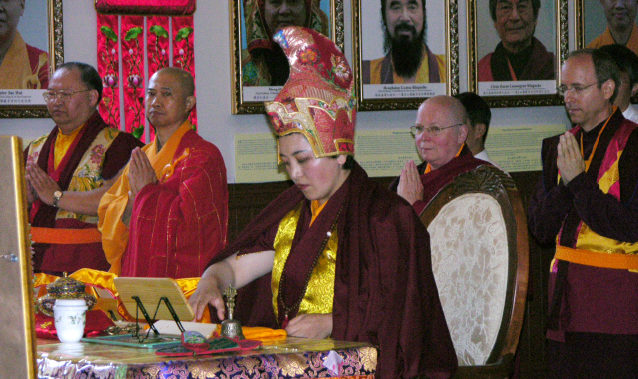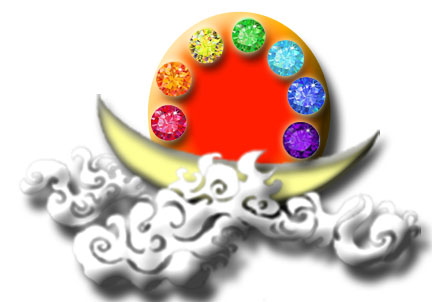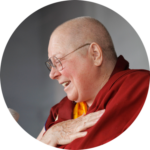We will continue to study the “Two Erroneous Views Concerning the Five Vidyas,” on August 9 at 2:00 pm. We will continue to use the “Seven-Dharmas System” for this series of classes. CLICK for rules, which I have revised to reflect our experience in using these for ZOOM. Let me know if you want to be a participant in the debate. You do not need to do that to be merely an observer and audit the class.
We will hold the Sunday morning chanting at 7:00 am on August 9 (CLICK to register)
Akou Lamo Rinpoche stated that traditionally, the vidyas are divided into the five major vidyas and the five minor vidyas. The five major vidyas are the silpakarmasthanavidya (craftsmanship vidya), the cikitsvidya (healing vidya), the sabdavidya (sound vidya), the hetuvidya (causality or Buddhist logic vidya), and the adhyatmavidya (inner realization vidya). The five minor vidyas are rhetoric, ornate diction, prosody, dramaturgy, and astronomy. Actually, the Five Vidyas are not that narrow. Everything in the universe can be classified into five aspects of brightness and darkness. To develop everything that is good in the universe and that benefits living beings is classified as “bright.” That which confuses and is bad is classified as “dark.” This is the real meaning of the Five Vidyas (Five Bright) of which the Buddha spoke.
Please study the following preliminary translations of brief discourses given by H.H. Dorje Chang Buddha III on erroneous views related to the Five Vidyas and the links provided on this page:
Erroneous View #37: Acknowledging that Bodhisattvas do not have to acquire the five vidyas –The sutras say that the Five Vidyas are attained by Bodhisattvas. However, some people say that Bodhisattvas are not necessarily proficient in the Five Vidyas. A question must be posed to those people about the truth. Are Bodhisattvas inferior to ordinary people? All great Bodhisattvas must be proficient in the Five Vidyas. If the wisdom of a so-called Bodhisattva does not even surpass that of ordinary people, he must be a false Bodhisattva, or at the very least he is not a great Bodhisattva. Think about it and you will understand. How can having wisdom power inferior to that of ordinary people possibly show that the composition of his body, speech and mind is that of a Bodhisattva who possesses holy wisdom power?
Erroneous View #58: Acknowledging one of insignificant achievements in the five vidyas as a person of great holiness and virtue or THE VIEW THAT REGARDS ONE WHO IS MEDIOCRE IN THE FIVE VIDYAS AS A PERSON OF GREAT HOLINESS AND VIRTUE–Although someone is mediocre in the Five Vidyas, some people still say that he is a person of great holiness and virtue because he is very good in certain aspects. This is wrong. You must understand that a person of great holiness and virtue is a great Bodhisattva. There are only very few of them on earth. Think about it. Can one with the wisdom of a great Bodhisattva have only mediocre abilities in the Five Vidyas? Could such a person be inferior to worldlings? A great Bodhisattva has tremendous wisdom. Manifesting the worldly Five Vidyas is an insignificant skill as far as a great Bodhisattva is concerned. Therefore, regarding one who is mediocre in the Five Vidyas as a great Bodhisattva or a person of great holiness and virtue is an erroneous view.
CLICK to register for August 9 and/or August 16, 2020 classesas we continue our study on “Two Erroneous Views on the Five Vidyas.”
Dalai Lama’s Definition of the Five Vidyas
CLICK for more on the Five Vidyas. You can also find more on the Five Vidyas, referred to as the “Five Branches of Learning” in Arya Asanga’s The Bodhisattva Path to Unsurpassed Enlightenment (Bodhisattvabhumi) as translated by Artemus B. Engle. This book published in 2016 also includes a forward by the Dalai Lama where he notes that the education of a bodhisattva includes not only “… the practice of meditation and cultivation of the six perfections–generosity, ethics, patience, effort, meditation, and wisdom–but encourages the acquisition of broad knowledge and general education in the pursuit of enlightenment. The focus of that education is the five sciences (vidyas) which include the study of Buddhist and non-Buddhist philosophical views (inner realization vidya), grammar (sound vidya), logic (causality vidya), medicine (healing vidya), and crafts (arts and craftsmanship vidya).” I believe that comparing this narrow definition to the teachings of the Buddha Master explains much of what the Buddha Master came to this world to correct. The translator gives slightly different categories, but comparing this to what the Buddha Master has taught us shows what has been lost in contemporary Buddhist doctrine and principles. I will provide more background on the Five VIdyas and summarize my research to hopefully provide additional examples of why it is important to understand the meaning of the Five Vidyas.





Dear Master ZZ: your excitement for the 5 vidyas was tangible and your explanation enlightening and the Buddha Master’s clarification of the term vidya is wonderfully expansive and encompassing in itself and as they relate to the Boddhsatva cultivation of the paramitas. Would that His intent for this
clarification to be spread to the larger Buddhist world be realized. Kudos to you and your wonderful sangha for making this Bodhisatvic outreach experience a reality.
I am so glad you were able to join us. I hope we can meet again in person. I think of you when I consider making “Imparting the Absolute Truth through the Heart Sutra” available. I cannot imagine flying now and am not allowing guests to stay at the temple who do either. Let us hope we will be able to travel again. Zhaxi Zhuoma
I second Ed’s emotion. My understanding of the meaning of the Five Vidyas was transformed by this class. They became a profound surprise. To me the Five Vidyas have always seemed “alchemical”, much the way I feel about the Four Great Elements: buckets of odds-and-ends, a dusty legacy from ancient cultures. But now I see that the Five Vidyas bring the Buddhist paths and methods together. They are the “dance” of cultivation with practice. They are the myriad patterns of interplay between mind and … itself! 🙂 I found myself thinking of a Hermann Hesse novel called (appropriately enough) “Journey to the East”.
The fact that all five are perfected by the botisattvas and Buddha’s give raise to
The work and commitment to the true Dharma so graciously given to us.
I think the filters are lifting and the work has just begun . Thank you Gesang
For your continued optimism and faith . And Master Z Z for your sword that breaks through and directs wisdom in this amazing work . Also a shout out to all students in the lemonade classes .